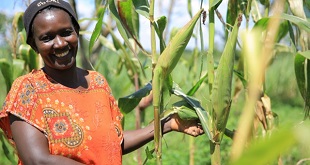
By Mubatsi Asinja Habati & Rukiya Makuma
Delayed diagnosis causes anxiety as over 30 people die
A forty-one year-old man from Wipolo village, Morulem subcounty in Abim district was the first recorded victim. He complained of headache and stomach pain on Oct 2 and by Oct. 7 he was dead.
The epidemiological report from the ministry of Health says his illness was characterised by vomiting blood, passing blood stool and general body weakness. He had attended a party where he reportedly drunk waragi and later kwete (all locally made brews) before falling ill. Other people who drunk the same brew at the party did not fall sick. Five family members who nursed him fell ill and his 12 year old son also succumbed to death. Other victims of this yet-to-be diagnosed disease have been presenting similar symptoms.
Samples from suspected cases in Abim were sent to Uganda Virus Research Institute Entebbe on Nov. 10 but Abim health office got the results on Nov. 14, four days later. The samples tested negative for Marburg and deadly Ebola among other hemorrhagic fevers. The disease has since spread to northern Uganda districts.
The disease that struck Abim, Kitgum, Agago, and Lamwo districts in the Acholi sub-region, had by early December claimed 31 lives and infected at least 96. By Dec 2, of the 15 cases that had been admitted to St Joseph Hospital in Kitgum 8 had died putting the fatality rate at 53%. In Abim of the 22 cases reported 10 had died by Nov. 24.

It has tentatively been identified as plague according to Solomon Fisseha, the focal point person at World Health Organisation (WHO) in Uganda. Fisseha says with plague, the infected persons usually start with flu-like symptoms after an incubation period of 3-7 days. Patients typically experience the sudden onset of fever, chills, head and body-aches and weakness, vomiting and nausea.
Plague, a bacterial disease carried by rodents, spreads to humans by infected fleas. It infects the lymph glands (bubonic plague), blood (septicemia plague), and lungs (pneumonic plague). Infections are spread by bites of infected fleas, direct contact with the tissues or body fluids of a plague-infected animal; by inhaling infectious airborne droplets from persons or animals with plague pneumonia; or by laboratory exposure to plague bacteria. Plague can be a very severe disease in people, with a case-fatality ratio of 30%-60% if left untreated.
But an epidemiologist from the Ministry of Health (MoH) who is on the team investigating the disease told The Independent that test results are pointing away from plague.
The disease, which was first reported in Morulem sub-county Abim district, has however not made as many headlines in the past few weeks as such attacks usually do. The government response to the disease remains lukewarm and the presidential election campaigns appear to have over-shadowed it. Suspected cases are only isolated when brought to hospitals and no quarantine has been imposed on affected villages.
Issa Makumbi, the Assistant Commissioner in the Ministry of health, says they are trying to control the situation at hand by isolating the affected and there is no need to alarm people. He says they encourage people to report to the health centers once they suspect or get any of the symptoms that have been identified with plague because it is contagious. By Dec. 10, there had been no new reported cases for the last four days.

Betty Apio the District Health Officer of Abim district says the challenge at the moment is failure to establish the real disease that is killing people. She says after the samples sent to the Entebbe Virus Research Institute tested negative for hemorrhagic fevers, more samples have been sent to Centers for Disease Control Atlanta, and to South Africa for further tests. She said that although it was earlier indicated that the disease could be bubonic plague, they are not sure of the disease yet.
Whereas the first victim of the disease died on Oct. 7, Abim district health office knew about the disease on Nov. 8 after more three people from Morulem subcounty had died in similar manner. By Nov. 12, when the disease spread to Agago, Lamwo and Kitgum districts, a team of investigators from the ministry of Health reported that there was an epizootic that needed specialised investigations as of Nov. 15. Ten days later a multidepartment team of health investigators from the ministry of health, WHO, CDC, AFENET, Ministry of Agriculture, Makerere University Faculty of Veterinary Medicine and School of Public Health arrived in Agago to facilitate the extended investigations and initiation of preliminary control measures. The investigators later visited Kitgum and Abim.
Apio says with support from the MoH and WHO, Abim has set up an emergency centre to handle cases that arise in the area at Morulem Health Centre III. The Ministry is still involved in an active search for victims and putting them in isolation centers, community social mobilisation, providing protective gear and drugs to control the infections and it has engaged with the Ministry of Agriculture and Animal Husbandry who are on the ground in Abim district to ascertain whether the undiagnosed disease is linked to the wild animals they eat.
But one of the epidemiological reports seen by The Independent complains of unqualified staff and inadequate equipment to handle the disease at the health centre.
In a consultative meeting that Abim district health deypartment had with MOH, WHO and other stakeholders on Dec 9, Apio says they resolved that health workers would oraganise sensitization campaigns in the district to inform people about the necessary protection measures.
Delay in diagnosing the disease has led to speculation that politics could be at play. It is election time.
President Yoweri Museveni, while campaigning in Karamoja, told voters that previous regimes failed to fight disease. Polio is a UPC disease, he has told them. His opponents have countered with accusations that President Museveni’s regime has failed, people are dying of jiggers and plague a disease that reveals a lot about people’s hygiene is taking its toll in northern Uganda. With over 30 people dead and more than 96 cases admitted to health centres, some critical voices say government response to the disease has been slow as compared to the time when the hemorrhagic Ebola fever broke out in Bundibugyo in 2007.
Ebola left at least 37 people dead including a doctor who had put his life on the line treating his people who suffered from then undiagnosed disease.
Many are recalling that Ebola broke out at a time when Uganda was days to hosting the Commonwealth heads of Government Meeting (CHOGM) and the reporting about the disease was very muted. Journalists who wanted to report it were getting sketchy answers.
CHOGM was held from November 22 – 25, 2007.
Before it was held the story was: No Ebola in Uganda – health official in The New Vision. The September 12 story quoted Dr Sam Okware, the Commissioner of Community Health.
Strange viral disease kills 20 in Bundibugyo reported the Daily Monitor on November 14, 2007 and Strange Disease Kills One More in the New Vision on November 26, 2007. At that point, 16 people had died.
By November 30, 2007, just five days after CHOGM, the story was: New Ebola strain found in Uganda.
Why was it so difficult to diagnose the disease before CHOGM and so easy after?
Dr Sam Zaramba, the Director General of Health Services, denied reports that the government had known about the deadly epidemic outbreak weeks earlier but concealed it in order not to scare away foreign dignitaries who were to attend CHOGM.
It would be unethical for me to keep quiet (about an epidemic outbreak). It is true we knew there was a strange disease in western Uganda but had not got the conclusive confirmation, he said.
Politics has also allegedly played a key role in the jiggers frenzy in Busoga in recent months. The government frantically poured Shs 400 million into Busoga to cleanse the locals of jiggers.
It is an unusual but common enough case that when there is a disease outbreak, governments try to downplay it to avoid bad publicity and panic. This was the case when the deadly severe acute respiratory syndrome (SARS) broke out in Hong Kong. Some 800 people had been infected and 20 died but authorities in Hong Kong kept claiming the disease was under control as more and more people were infected and refused to impose a travel quarantine to badly hit areas. The US government has also been accused of hiding information about the outbreak of mad cow disease for a period of 8 years.
In Uganda’s case, Assistant Commissioner in the Ministry of health Makumbi says they have warned people against eating wild animals after the initial samples showed that some people had plague though they are not sure whether the plague was contracted from animals. Every patient is being treated for plague and some patients are recovering while others are still receiving treatment.
Fisseha also says there is still need to do further investigation and WHO is working closely with the MOH and partners to ascertain the cause and institute appropriate control measures.
 The Independent Uganda: You get the Truth we Pay the Price
The Independent Uganda: You get the Truth we Pay the Price



